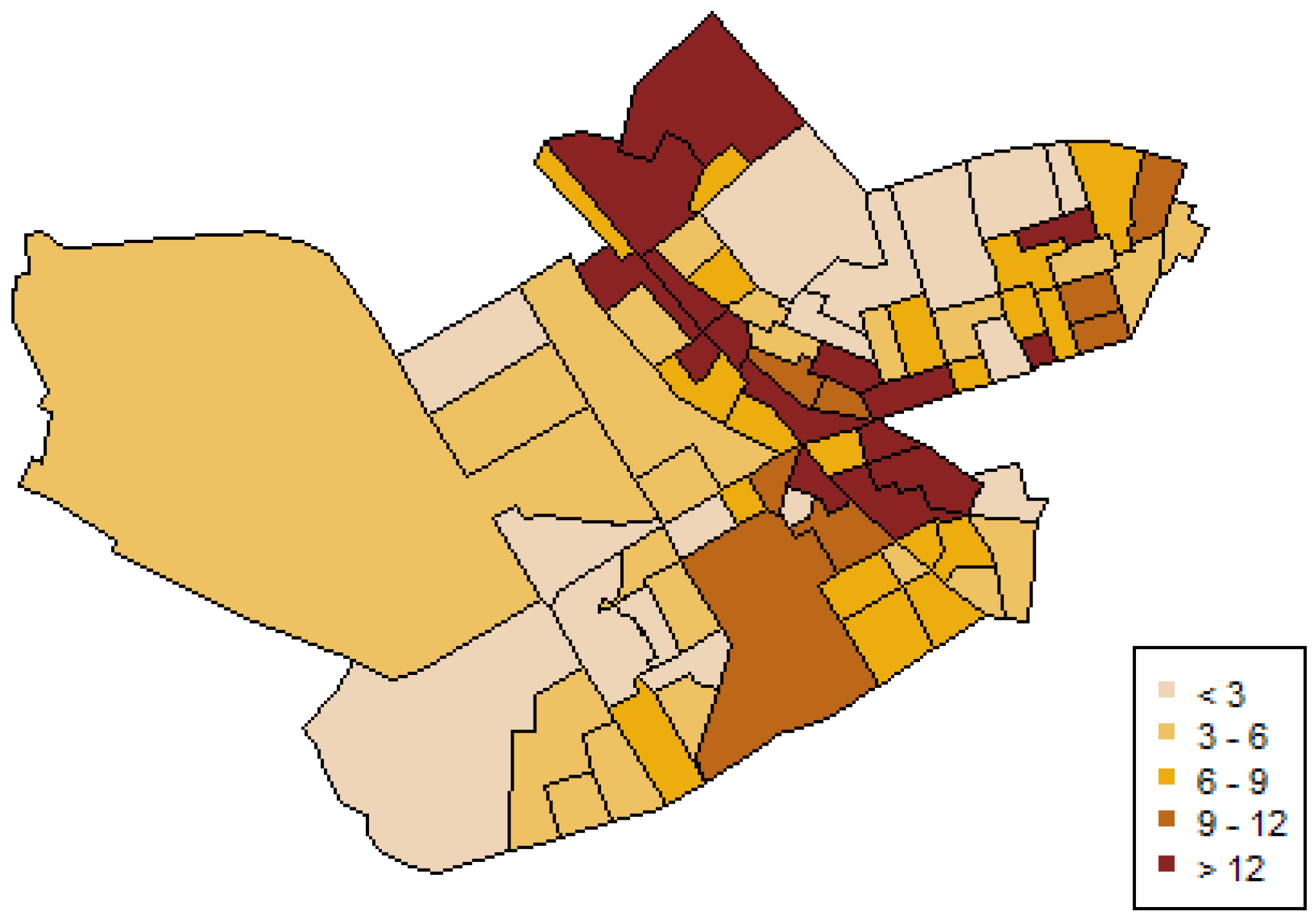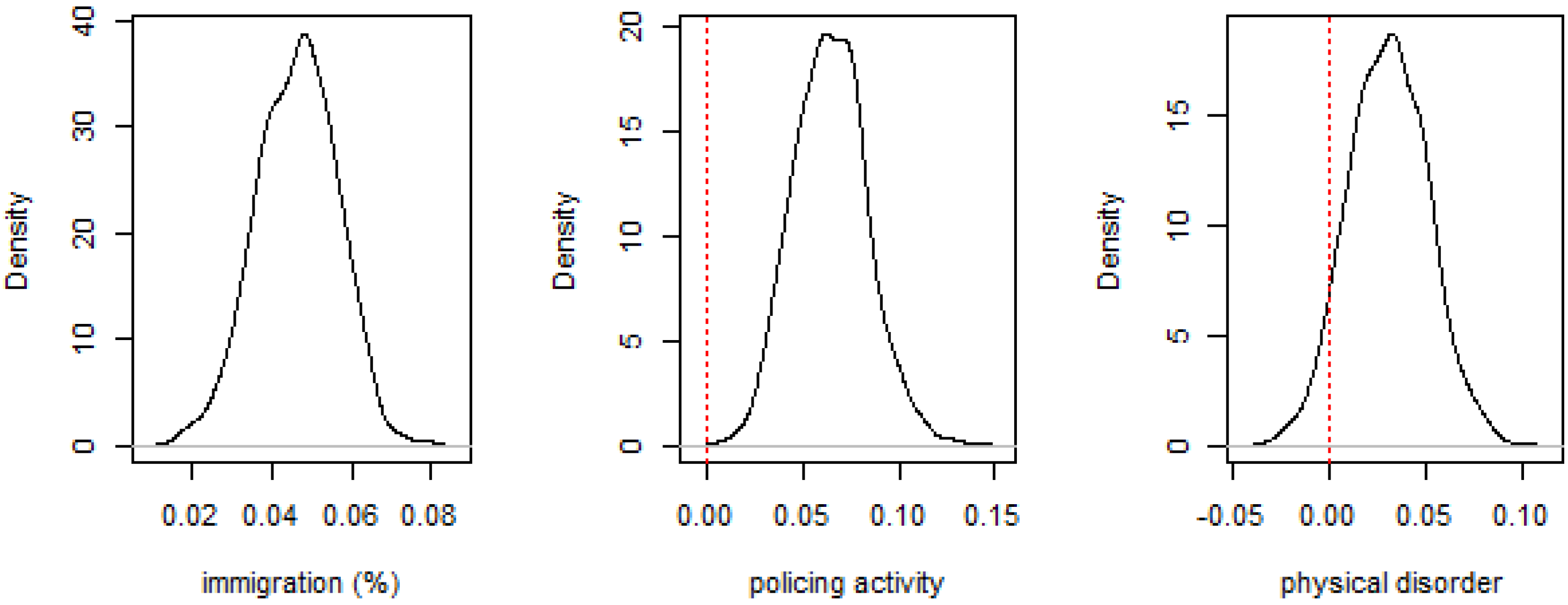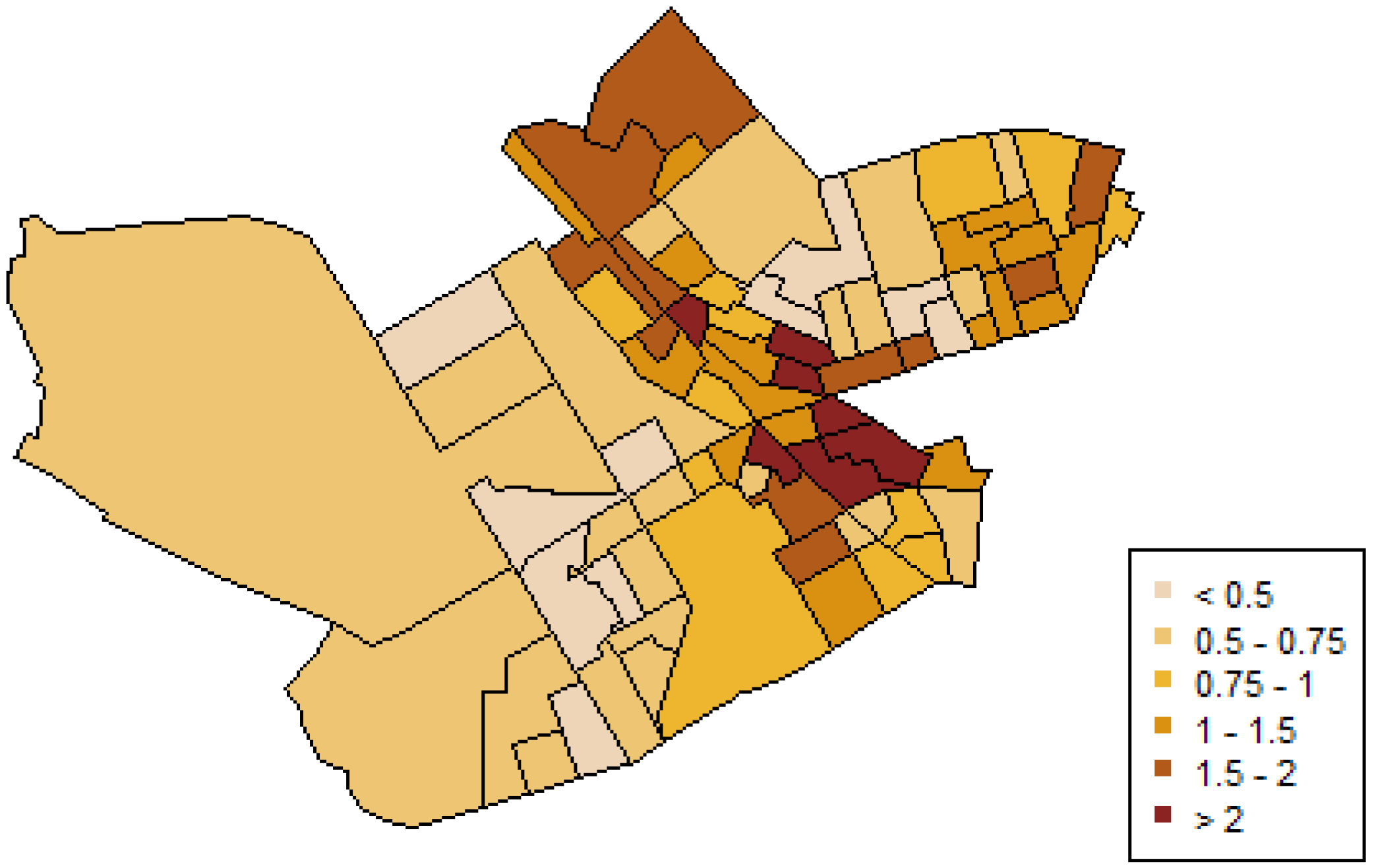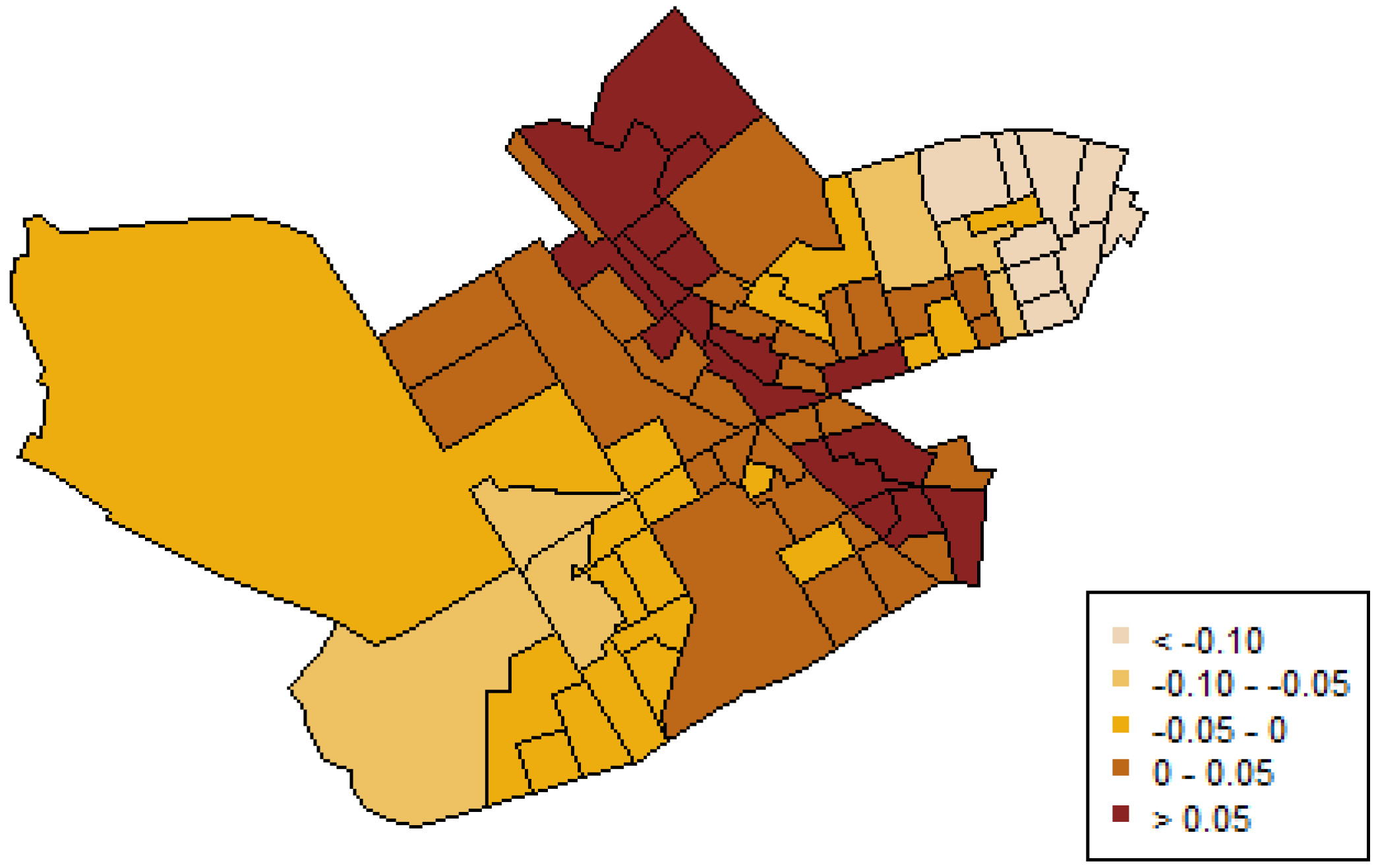Exploring Neighborhood Influences on Small-Area Variations in Intimate Partner Violence Risk: A Bayesian Random-Effects Modeling Approach
Abstract
:1. Introduction
2. Data

| Variable | Mean | SD | Min. | Max. |
|---|---|---|---|---|
| Population | 1,476 | 439.61 | 829 | 2,559 |
| Women > 16 years | 651.3 | 191.15 | 361 | 1,174 |
| Property value | 22,440 | 9,160 | 11,190 | 52,580 |
| % Immigration | 16.58 | 6.85 | 6.33 | 33.17 |
| Policing activity | 10.16 | 3.56 | 2 | 18 |
| Social Disorder | 0.29 | 0.75 | 0 | 4 |
| Physical Disorder | 6.2 | 3.26 | 0 | 16 |
| Residential Mobility | 22.92 | 6.01 | 11.39 | 34.52 |
3. Methods

 ) where σH ~ U (0,1). The prior information of standard deviation of spatial effect is also a uniform distribution σS ~ U (0,1).
) where σH ~ U (0,1). The prior information of standard deviation of spatial effect is also a uniform distribution σS ~ U (0,1). [68] which was near to 1.0 for all parameters. A sensitivity analysis on prior distributions of hyperparameters was performed to measure the robustness of the results. The posterior distributions showed the consistency of results. Finally, models were compared by considering the Deviance Information Criterion (DIC) [69], which is computed routinely by WinBUGS. The model with the smaller DIC value was chosen.
[68] which was near to 1.0 for all parameters. A sensitivity analysis on prior distributions of hyperparameters was performed to measure the robustness of the results. The posterior distributions showed the consistency of results. Finally, models were compared by considering the Deviance Information Criterion (DIC) [69], which is computed routinely by WinBUGS. The model with the smaller DIC value was chosen.4. Results
| Explanatory Variables | Non-spatial Poisson (Model 1) | Spatial Poisson (Model 2) | Final Spatial Model (Model 3) |
|---|---|---|---|
| Mean (95% CI) | Mean (95% CI) | Mean (95% CI) | |
| Intercept | −1.154 (−1.965, −2.99) | −1.221 (−2.291, −0.153) | −1.715 (−2.193, −1.253) |
| Property Value a | −0.104 (−0.331, 0.102) | −0.092 (−0.359, 0.175) | -- |
| Immigration | 0.046 (0.011, 0.080) | 0.049 (0.006, 0.095) | 0.046 (0.026, 0.064) |
| Policing Activity | 0.056 (0.022, 0.093) | 0.057 (0.016, 0.099) | 0.064 (0.0287, 0.104) |
| Social Disorder | 0.025 (−0.102, 0.148) | 0.036 (−0.134, 0.199) | -- |
| Physical Disorder | 0.034 (0, 0.07) | 0.030 (−0.013, 0.074) | 0.030 (−0.009, 0.071) |
| Residential Instability | −0.010 (−0.042, 0.001) | −0.012 (−0.052, 0.029) | -- |
| σS | -- | 0.232 (0.012, 0.587) | 0.232 (0.010, 0.576) |
| σH | -- | 0.205 (0.015, 0.407) | 0.190 (0.004, 0.378) |
| DIC | 355.6 | 353.7 | 348.9 |
| pD | 6.9 | 25.1 | 21.193 |



5. Discussion and Conclusions
Acknowledgments
Conflicts of Interest
References
- Campbell, J.C. Health consequences of intimate partner violence. Lancet 2002, 359, 1331–1336. [Google Scholar] [CrossRef]
- World Health Organization. World Report on Violence and Health; World Health Organization: Geneva, Switzerland, 2002. [Google Scholar]
- Campbell, J.; Jones, A.S.; Dienemann, J.; Kub, J.; Schollenberger, J.; O’campo, P.; Gielen, A.C.; Wynne, C. Intimate partner violence and physical health consequences. Arch. Intern. Med. 2002, 162, 1157–1163. [Google Scholar] [CrossRef]
- Coker, A.L.; Davis, K.E.; Arias, I.; Desai, S.; Sanderson, M.; Brandt, H.M.; Smith, P.H. Physical and mental health effects of intimate partner violence for men and women. Am. J. Prev. Med. 2002, 23, 260–268. [Google Scholar] [CrossRef]
- Ellsberg, M.; Jansen, H.A.; Heise, L.; Watts, C.H.; Garcia-Moreno, C. Intimate partner violence and women’s physical and mental health in the WHO multi-country study on women’s health and domestic violence: An observational study. Lancet 2008, 371, 1165–1172. [Google Scholar] [CrossRef]
- Sarkar, N.N. The impact of intimate partner violence on women’s reproductive health and pregnancy outcome. J. Obstet. Gynecol. 2008, 28, 266–271. [Google Scholar] [CrossRef]
- World Health Organization. Global and Regional Estimates of Violence against Women: Prevalence and Health Effects of Intimate Partner Violence and Non-Partner Sexual Violence; World Health Organization: Geneva, Switzerland, 2013. [Google Scholar]
- Heise, L.L. Violence against women: An integrated, ecological framework. Violence Against Women 1998, 4, 262–290. [Google Scholar] [CrossRef]
- Van Wyk, J.A.; Benson, M.L.; Fox, G.L.; DeMaris, A. Detangling individual-, partner-, and community-level correlates of partner violence. Crime Delinq. 2003, 49, 412–438. [Google Scholar] [CrossRef]
- O’Campo, P.; Gielen, A.C.; Faden, R.R.; Xue, X.; Kass, N.; Wang, M.C. Violence by male partners against women during the childbearing year: A contextual analysis. Am. J. Public Health 1995, 85, 1092–1097. [Google Scholar] [CrossRef]
- Gracia, E.; Herrero, J. Acceptability of domestic violence against women in the European Union: A multilevel analysis. J. Epidemiol. Community Health 2006, 60, 123–129. [Google Scholar] [CrossRef]
- Shaw, C.R.; McKay, H.D. Juvenile Delinquency and Urban Areas; University of Chicago Press: Chicago, IL, USA, 1942. [Google Scholar]
- Bursik, R.J.; Grasmick, H.G. Neighborhood and Crime; Lexington Books: New York, NY, USA, 1993. [Google Scholar]
- Sampson, R.J.; Raudenbush, S.W.; Earls, F. Neighborhood and violent crime: A multilevel study of collective efficacy. Science 1997, 277, 918–924. [Google Scholar] [CrossRef]
- Morenoff, J.D.; Sampson, R.J.; Raudenbush, S.W. Neighborhood inequality, collective efficacy, and the spatial dynamics of urban violence. Criminology 2001, 39, 517–558. [Google Scholar] [CrossRef]
- McNulty, T.L.; Bellair, P.E. Explaining racial and ethnic differences in adolescent violence: Structural disadvantage, family well-being, and social capital. Justice Q. 2003, 20, 1–31. [Google Scholar] [CrossRef]
- Browning, C.R.; Byron, R.A.; Calder, C.A.; Krivo, L.J.; Kwan, M.-P.; Lee, J.-Y.; Peterson, R.D. Commercial density, residential concentration, and crime: Land use patterns and violence in neighborhood context. J. Res. Crime Delinq. 2010, 47, 329–357. [Google Scholar] [CrossRef]
- Maimon, D.; Browning, C.R. Unstructured socializing, collective efficacy, and violence behavior among urban youth. Criminology 2010, 48, 443–474. [Google Scholar] [CrossRef]
- Garbarino, J.; Sherman, D. High-risk neighbourhoods and high-risk families: The human ecology of child maltreatment. Child Dev. 1980, 51, 188–198. [Google Scholar] [CrossRef]
- Coulton, C.J.; Korbin, J.E.; Su, M. Neighborhoods and child maltreatment: A multilevel study. Child Abuse Negl. 1999, 23, 1019–1040. [Google Scholar] [CrossRef]
- Korbin, J.E. Neighborhood and community connectedness in child maltreatment research. Child Abuse Negl. 2003, 27, 137–140. [Google Scholar] [CrossRef]
- Gracia, E.; Herrero, J. Perceived neighborhood social disorder and residents’ attitudes toward reporting child physical abuse. Child Abuse Negl. 2006, 30, 357–365. [Google Scholar] [CrossRef]
- Coulton, C.J.; Crampton, D.S.; Irwin, M.; Spilsbury, J.C.; Korbin, J.E. How neighborhoods influence child maltreatment: A review of the literature and alternative pathways. Child Abuse Negl. 2007, 31, 1117–1142. [Google Scholar] [CrossRef]
- Miles-Doan, R.; Kelly, S. Geographic concentration of violence between intimate partners. Public Health Rep. 1997, 112, 135–141. [Google Scholar]
- O’Campo, P.; Burke, J.; Peak, G.L.; McDonnell, K.A.; Gielen, A.C. Uncovering neighbourhood influences on intimate partner violence using concept mapping. J. Epidemiol. Community Health 2005, 59, 603–608. [Google Scholar] [CrossRef]
- Burke, J.G.; O’Campo, P.; Peak, G.L. Neighborhood influences and intimate partner violence: Does geographic setting matter? J. Urban Health 2006, 83, 182–194. [Google Scholar] [CrossRef]
- Frye, V. The informal social control of intimate partner violence against women: Exploring personal attitudes and perceived neighborhood social cohesion. J. Community Psychol. 2007, 35, 1001–1018. [Google Scholar] [CrossRef]
- Gracia, E.; Herrero, J. Perceived neighborhood social disorder and attitudes towards reporting domestic violence against women. J. Interpers. Violence 2007, 22, 737–752. [Google Scholar] [CrossRef]
- Frye, V.; O’Campo, P. Neighborhood effects and intimate partner and sexual violence: Latest results. J. Urban Health 2011, 88, 187–190. [Google Scholar] [CrossRef]
- Pinchevsky, G.M.; Wright, E.M. The impact of neighborhoods on intimate partner violence and victimization. Trauma Violence Abuse 2012, 13, 112–132. [Google Scholar]
- Browning, C.R. The span of collective efficacy: Extending social disorganization theory to partner violence. J. Marriage Fam. 2002, 64, 833–850. [Google Scholar] [CrossRef]
- Cunradi, C.B.; Caetano, R.; Clark, C.; Schafer, J. Neighborhood poverty as a predictor of intimate partner violence among white, black, and hispanic couples in the United States: A multilevel analysis. Ann. Epidemiol. 2000, 10, 297–308. [Google Scholar] [CrossRef]
- Benson, M.L.; Fox, G.L.; DeMaris, A.; Van Wyk, J. Neighborhood disadvantage, individual economic distress and violence against women in intimate relationships. J. Quant. Criminol. 2003, 19, 207–235. [Google Scholar] [CrossRef]
- Pearlman, D.N.; Zierler, S.; Gjelsvik, A.; Verhoek-Oftedahl, W. Neighborhood environment, racial position, and risk of police-reported domestic violence: a contextual analysis. Public Health Rep. 2003, 118, 44–58. [Google Scholar]
- Cunradi, C.B. Intimate partner violence among Hispanic men and women: The role of drinking, neighborhood disorder, and acculturation-related factors. Violence Vict. 2009, 24, 83–97. [Google Scholar] [CrossRef]
- Li, Q.; Kirby, R.S.; Sigler, R.T.; Hwang, S.; LaGory, M.E.; Goldenberg, R.L. A multilevel analysis of individual, household, and neighborhood correlates of intimate partner violence among low-income pregnant women in Jefferson County, Alabama. Am. J. Public Health 2010, 100, 531–539. [Google Scholar] [CrossRef]
- Cunradi, C.B.; Mair, C.; Ponicki, W.; Remer, L. Alcohol outlets, neighborhood characteristics, and intimate partner violence: Ecological analysis of a California city. J. Urban Health 2011, 88, 191–200. [Google Scholar] [CrossRef]
- Wright, E.M.; Benson, M.L. Clarifying the effects of neighborhood disadvantage and collective efficacy on violence “behind closed doors”. Justice Q. 2011, 28, 775–798. [Google Scholar] [CrossRef]
- Jewkes, R. Intimate partner violence: Causes and prevention. Lancet 2002, 359, 1423–1429. [Google Scholar] [CrossRef]
- Gracia, E.; Herrero, J. Public attitudes toward reporting partner violence against women and reporting behavior. J. Marriage Fam. 2006, 68, 759–768. [Google Scholar] [CrossRef]
- Raghavan, C.; Mennerich, A.; Sexton, E.; James, S.E. Community violence and its direct, indirect, and mediating effects on intimate partner violence. Violence Against Women 2006, 12, 1132–1149. [Google Scholar] [CrossRef]
- Gracia, E.; García, F.; Lila, M. Public responses to intimate partner violence against women: The influence of perceived severity and personal responsibility. Span. J. Psychol. 2009, 12, 648–656. [Google Scholar] [CrossRef]
- Reed, E.; Silverman, J.G.; Welles, S.L.; Santana, M.C.; Missmer, S.A.; Raj, A. Associations between neighborhood violence and intimate partner violence perpetration among urban, African American men. J. Community Health 2009, 34, 328–335. [Google Scholar] [CrossRef]
- Caetano, R.; Ramisetty-Mikler, S.; Harris, T.R. Neighborhood characteristics as predictors of male to female and female to male partner violence. J. Interpers. Violence 2010, 25, 1986–2009. [Google Scholar] [CrossRef]
- Lila, M.; Gracia, E.; Murgui, S. Psychological adjustment and victim-blaming among intimate partner violence offenders: The role of social support and stressful life events. Eur. J. Psychol. Appl. Legal Context 2013, 5, 147–153. [Google Scholar] [CrossRef]
- Clayton, D.G.; Kaldor, J. Empirical Bayes estimates of age-standardized relative risks for use in disease mapping. Biometrics 1987, 43, 671–681. [Google Scholar] [CrossRef]
- Bernardinelli, L.; Clayton, D.; Pascutto, C.; Montomoli, C.; Ghislandi, M.; Songini, M. Bayesian analysis of space-time variation in disease risk. Stat. Med. 1995, 14, 2433–2443. [Google Scholar] [CrossRef]
- Waller, L.A.; Gotway, C.A. Applied Spatial Statistics for Public Health Data; John Wiley and Sons: Hoboken, NJ, USA, 2004. [Google Scholar]
- Lawson, A.B. Bayesian Disease Mapping: Hierarchical Modeling in Spatial Epidemiology; CRC Press: Boca Raton, FL, USA, 2009. [Google Scholar]
- Zhu, L.; Gorman, D.M.; Horel, S. Hierarchical Bayesian spatial models for alcohol availability, drug “hot spots” and violent crime. Int. J. Health Geogr. 2006, 5. [Google Scholar] [CrossRef]
- Matthews, S.A.; Yang, T.C.; Hayslett, K.L.; Ruback, R.B. Built environment and property crime in Seattle, 1998–2000: A Bayesian analysis. Environ. Plan. A. 2010, 42, 1403–1420. [Google Scholar] [CrossRef]
- Sparks, C.S. Violent crime in San Antonio, Texas: An application of spatial epidemiological methods. Spat. Spatiotemporal Epidemiol. 2011, 2, 301–309. [Google Scholar] [CrossRef]
- Law, J.; Quick, M. Exploring links between juvenile offenders and social disorganization at a large map scale: A Bayesian spatial modeling approach. J. Geogr. Syst. 2013, 15, 89–113. [Google Scholar] [CrossRef]
- Law, J.; Quick, M.; Chan, P. Bayesian spatio-temporal modeling for analysing local patterns of crime over time at the small-area level. J. Quant. Criminol. 2013, 2013. [Google Scholar] [CrossRef]
- Congdon, P. Assessing the impact of socioeconomic variables on small area variations in suicide outcomes in England. Int. J. Environ. Res. Public Health 2013, 10, 158–177. [Google Scholar] [CrossRef]
- Jonker, M.F.; Congdon, P.D.; van Lenthe, F.J.; Donkers, B.; Burdorf, A.; Mackenbach, J.P. Small-area health comparisons using health-adjusted life expectancies: A Bayesian random-effects approach. Health Place 2013, 23, 70–78. [Google Scholar] [CrossRef]
- The Effects of Using Census Block Groups Instead of Using Census Tracts when Examining Residential Housing Patterns Website. Available online: http://www.census.gov/hhes/www/housing/resseg/pdf/unit_of_analysis.pdf (accessed on 23 November 2013).
- Sampson, R.J.; Raudenbush, S.W. Seeing disorder: Neighborhood stigma and the social construction of “broken windows”. Soc. Psychol. Q. 2004, 67, 319–342. [Google Scholar] [CrossRef]
- Yonas, M.; Akers, A.Y.; Burke, J.G.; Chang, J.C.; Thomas, A.L.; O’Campo, P. Perceptions of prominent neighborhood individuals regarding neighborhood factors and intimate partner violence. J. Urban Health 2011, 88, 214–224. [Google Scholar] [CrossRef]
- Johnson, M.P. Patriarchal terrorism and common couple violence: Two forms of violence against women. J. Marriage Fam. 1995, 57, 283–294. [Google Scholar] [CrossRef]
- Johnson, M.P.; Leone, J.M. The differential effects of intimate terrorism and situational couple violence findings from the national violence against women survey. J. Fam. Issues 2005, 26, 322–349. [Google Scholar] [CrossRef]
- Ratcliffe, J.H. Geocoding crime and a first estimate of a minimum acceptable hit rate. Int. J. Geogr. Inf. Sci. 2004, 18, 61–72. [Google Scholar] [CrossRef]
- Sampson, R.J.; Raudenbush, S.W. Systematic social observation of public spaces: A new look at disorder in urban neighborhoods. Am. J. Sociol. 1999, 105, 603–651. [Google Scholar]
- Skogan, W. Disorder and Decline: Crime and the Spiral of Decay in American Cities; University of California Press: Berkeley, CA, USA, 1990. [Google Scholar]
- Taylor, R.B. Breaking away from Broken Windows: Baltimore Neighborhoods and the Nationwide Fight against Crime, Grime, Fear, and Decline; Westview: Boulder, CO, USA, 2001. [Google Scholar]
- Wilson, J.Q.; Kelling, G. The police and neighborhood safety: Broken windows. Atl. Mon. 1982, 127, 29–38. [Google Scholar]
- Perkins, D.D.; Taylor, R.B. Ecological assessments of community disorder: Their relationship to fear of crime and theoretical implications. Am. J. Community Psychol. 1996, 24, 63–107. [Google Scholar] [CrossRef]
- Gelman, A.; Carlin, J.; Stern, H.; Rubin, D. Bayesian Data Analysis, 2nd ed.; CRC Press: Boca Raton, FL, USA, 1990. [Google Scholar]
- Spiegelhalter, D.J.; Best, N.G.; Carlin, B.P.; Van der Linde, A. Bayesian measures of complexity and fit. J. R. Stat. Soc. 2002, 64, 583–639. [Google Scholar] [CrossRef]
- Wright, E.M.; Benson, M.L. Immigration and intimate partner violence: Exploring the immigrant paradox. Soc. Probl. 2010, 57, 480–503. [Google Scholar] [CrossRef]
- Gracia, E.; Herrero, J.; Lila, M.; Fuente, A. Perception of social disorder in the neighborhood and attitudes toward partner violence against women in Latin-American immigrants. Eur. J. Psychol. Appl. Legal Context 2009, 1, 25–43. [Google Scholar]
- Raj, A.; Silverman, J.G. Violence against immigrant women: The roles of culture, context, and legal immigrant status on intimate partner violence. Violence Against Women 2002, 8, 367–398. [Google Scholar] [CrossRef]
- Hazen, A.L.; Soriano, F.I. Experiences with intimate partner violence among Latina women. Violence Against Women 2007, 13, 562–582. [Google Scholar] [CrossRef]
- Morash, M.; Bui, H.; Zhang, Y.; Holtfreter, K. Risk factors for abusive relationships: A study of Vietnamese American immigrant women. Violence Against Women 2007, 13, 653–675. [Google Scholar] [CrossRef]
- Benson, M.; Wooldredge, J.; Thistlethwaite, A.; Fox, G. The correlation between race and domestic violence is confounded with community context. Soc. Probl. 2004, 51, 326–342. [Google Scholar] [CrossRef]
- Sampson, R.J.; Lauritsen, J.L. Violent Victimization and Offending: Individual-, Situational-, and Community-Level Risk Factors. In Understanding and Preventing Violence: Social Influences; Reiss, A.J., Roth, J., Eds.; National Academy Press: Washington, DC, USA, 1993; Volume 3, pp. 1–114. [Google Scholar]
- Sampson, R.J.; Morenoff, J.D.; Raudenbush, S. Social anatomy of racial and ethnic disparities in violence. Am. J. Public Health 2005, 95, 224–232. [Google Scholar] [CrossRef]
- Miles-Doan, R. Violence between spouses and intimates: Does neighborhood context matter? Soc. Forces 1998, 77, 623–646. [Google Scholar]
- DeKeseredy, W.S.; Schwartz, M.D.; Alvi, S.; Tomaszewski, E.A. Perceived collective efficacy and women’s victimization in public housing. Criminol. Crim. Justice 2003, 3, 5–27. [Google Scholar] [CrossRef]
- Koenig, M.A.; Stephenson, R.; Ahmed, S.; Jejeebhoy, S.J.; Campbell, J. Individual and contextual determinants of domestic violence in North India. Am. J. Public Health 2006, 96, 132–138. [Google Scholar] [CrossRef]
- Skogan, W.G. Fear of Crime and Neighborhood Change. In Communities and Crime; Reiss, A.J., Tonry, M., Eds.; University of Chicago Press: Chicago, IL, USA, 1986; pp. 203–230. [Google Scholar]
- Cunradi, C.B. Neighborhoods, alcohol outlets and intimate partner violence: Addressing research gaps in explanatory mechanisms. Int. J. Environ. Res. Public Health 2010, 7, 799–813. [Google Scholar] [CrossRef]
- Gracia, E.; Tomás, J.M. Correlates of victim-blaming attitudes regarding partner violence against women among the Spanish general population. Violence Against Women. in press.
- Congdon, P. Spatially interpolated disease prevalence estimation using collateral indicators of morbidity and ecological risk. Int. J. Environ. Res. Public Health 2013, 10, 5011–5025. [Google Scholar] [CrossRef]
- Merlo, J. Contextual influences on the individual life course: Building a research framework for social epidemiology. Psychosoc. Interv. 2011, 20, 111–121. [Google Scholar] [CrossRef]
- Sampson, R.J.; Morenoff, J.D.; Gannon-Rowley, T. Assessing “neighborhood effects”: Social processes and new directions in research. Annu. Rev. Sociol. 2002, 28, 443–478. [Google Scholar] [CrossRef]
© 2014 by the authors; licensee MDPI, Basel, Switzerland. This article is an open access article distributed under the terms and conditions of the Creative Commons Attribution license (http://creativecommons.org/licenses/by/3.0/).
Share and Cite
Gracia, E.; López-Quílez, A.; Marco, M.; Lladosa, S.; Lila, M. Exploring Neighborhood Influences on Small-Area Variations in Intimate Partner Violence Risk: A Bayesian Random-Effects Modeling Approach. Int. J. Environ. Res. Public Health 2014, 11, 866-882. https://doi.org/10.3390/ijerph110100866
Gracia E, López-Quílez A, Marco M, Lladosa S, Lila M. Exploring Neighborhood Influences on Small-Area Variations in Intimate Partner Violence Risk: A Bayesian Random-Effects Modeling Approach. International Journal of Environmental Research and Public Health. 2014; 11(1):866-882. https://doi.org/10.3390/ijerph110100866
Chicago/Turabian StyleGracia, Enrique, Antonio López-Quílez, Miriam Marco, Silvia Lladosa, and Marisol Lila. 2014. "Exploring Neighborhood Influences on Small-Area Variations in Intimate Partner Violence Risk: A Bayesian Random-Effects Modeling Approach" International Journal of Environmental Research and Public Health 11, no. 1: 866-882. https://doi.org/10.3390/ijerph110100866
APA StyleGracia, E., López-Quílez, A., Marco, M., Lladosa, S., & Lila, M. (2014). Exploring Neighborhood Influences on Small-Area Variations in Intimate Partner Violence Risk: A Bayesian Random-Effects Modeling Approach. International Journal of Environmental Research and Public Health, 11(1), 866-882. https://doi.org/10.3390/ijerph110100866







